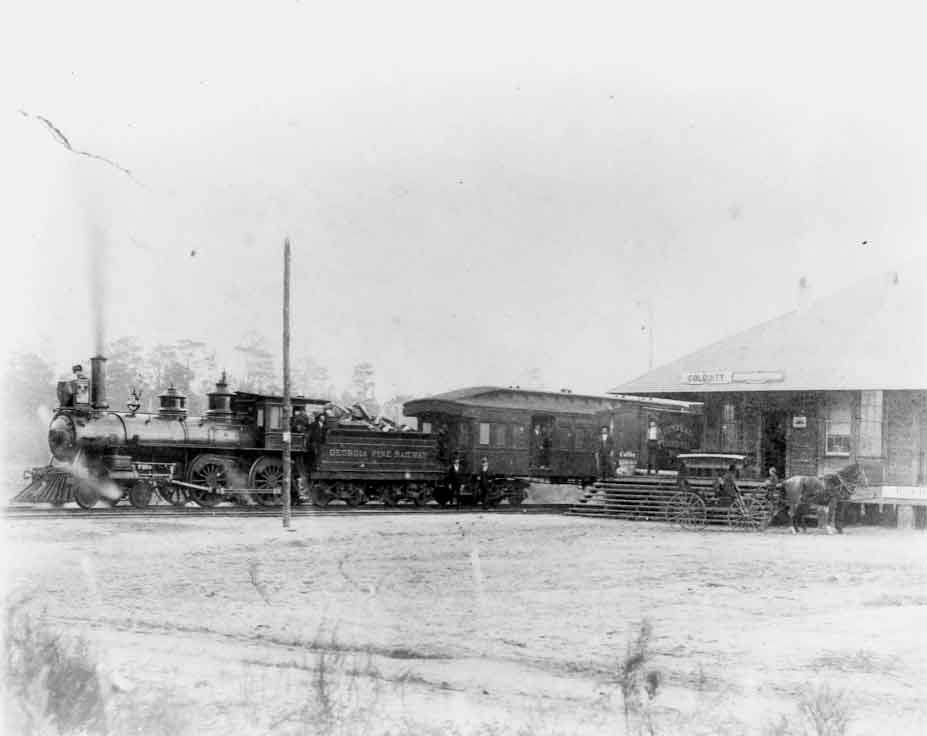
The story of the
Georgia Florida & Alabama RR
by
Donald R. Hensley, Jr.
Photos from the Florida Photographic Collection, State of Florida Archives, unless noted otherwise.
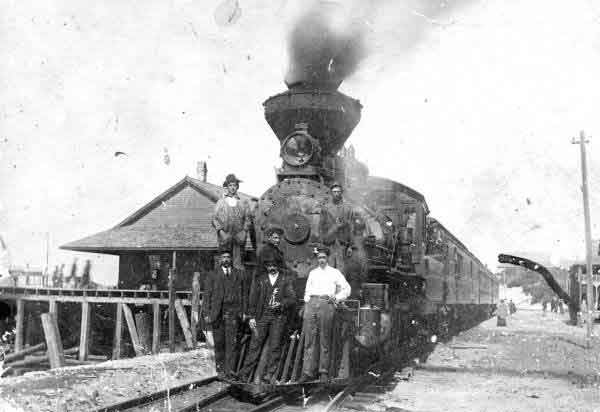
Train time at Carrabelle on the GF&A.
Today
CSX's Bainbridge, Ga to Tallahassee, Fla.
mainline was once two
struggling short line railroads that were founded to harvest the rich
yellow pine forest in southwest Georgia and northern Florida. The story
begins as two short lines began their struggles, one pushing north from
Carrabelle, Florida, the other heading south from Bainbridge, Ga.
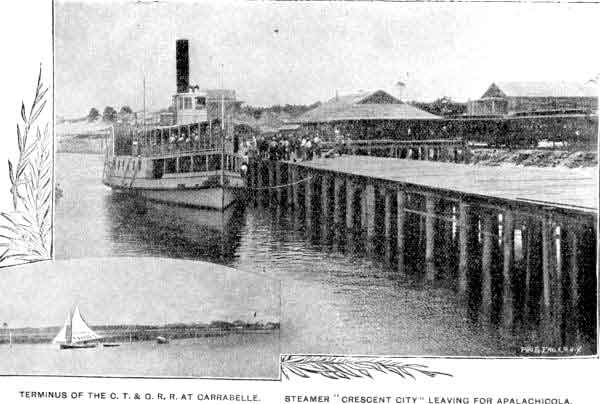
The road from Carrabelle began in 1883, when the Florida Legislature granted the Thomasville, Tallahassee & Gulf RR a charter. The railroad was to run north from the Gulf of Mexico port of Carrabelle to Thomasville, Ga, via Tallahassee. The railroad was only able to build 11-1/2 miles from Carrabelle when it met its first obstacle, the Sopchoppy River. Unable to secure funding for the large bridge the railroad was stopped dead in its tracks. At this point the railroad did own one unknown locomotive, which was used for construction, but no regular trains were operated. As they could not obtain financial backing , they did what most poor railroads do, they changed their name and obtained a new state charter. They were now known in 1889 as the Augusta, Tallahassee & Gulf and they quietly took over the old railroad. But this company also floundered until by chance William Clark of the Clark Thread Co. purchased 175,000 acres of pine lands near the railroad. Clark needed the pine as a supply of thread spools and he needed a solvent railroad to transport the pine. He purchased the Augusta Tallahassee & Gulf in 1891 and reorganized it as the Carrabelle, Tallahassee & Georgia RR on January 5th. Clark soon hired the contractor who had just built the famous Brooklyn Bridge and sent them south to Florida to built the less famous Sopchoppy Bridge. They brought along two feisty 0-4-0ts for construction which stayed with the railroad. The CT&G quickly purchased the old AT&G in 1892 and began construction of the bridge and the pushed north to Tallahassee, reaching the city by October of 1893. For a reward the CT&G received a state land grant of 206,370 acres, though they were promised 600,000 acres. In Tallahassee the CT&G connected with the Florida Central & Peninsular, which ran east and west, connecting the railroad with Jacksonville and Chattahoochee. The FC&P would soon be absorbed by the Seaboard Air Line.
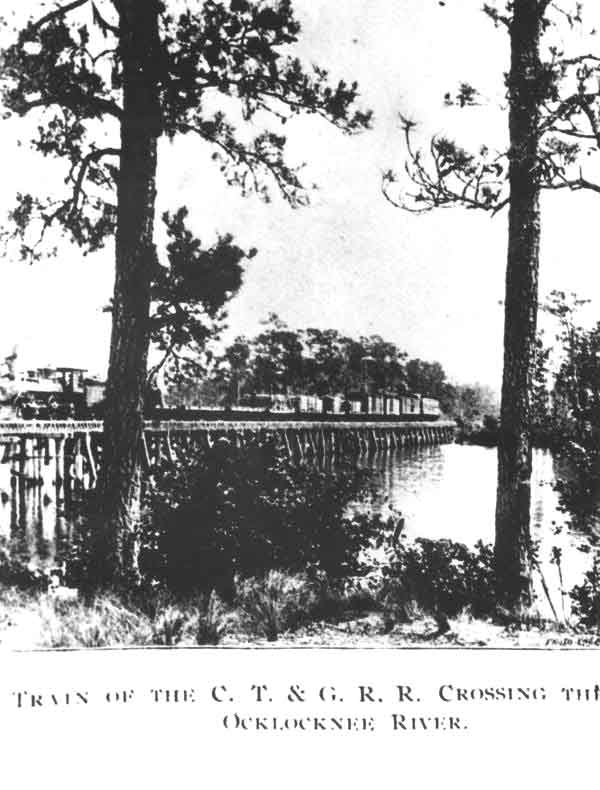
Meanwhile in 1895, a Savannah lumberman by the name of John P. Williams, was needing a railroad to be built through his pine lands south of Bainbridge, Ga. He quickly incorporated the Georgia Pine Railway on September 13, 1895. The railroad slowly built south from Bainbridge, reaching 40 miles to Arlington, Ga in 1897. Seeing an opportunity to reach Tallahassee and its Jacksonville connection he proceeded to build 41 miles further south, reaching the Florida capital city in 1902. At the same time he built north 25 miles to Cuthbert, Ga.
Then something wonderful happened to the Georgia Pine Ry., instead of a logging and naval stores hauling short line, bridge traffic started creeping into the mix. Being a north and south railroad in a section of Georgia that was all east and west roads, bridge traffic began forming at all its connections as short cuts to Alabama, Southwest Georgia and points in Florida. Williams realized his good luck in 1901 and reincorporated the railroad as the Georgia Florida and Alabama, a name more reflective of his regional traffic. In 1904 he leased the struggling CT&G, buying it outright in 1906. Williams also realize that if he reached the Seaboard mainline at Richland, Georgia, he could secure a bridge route between two Seaboard mainlines. He began an extension to Richland, finishing up in 1910. The last bit of construction was a short branch from Havana to Quincy, Fla., an important tobacco farming and fullers earth mining town.
The new GF&A stretched 192 miles from Carrabelle, Fla. to Richland, Ga, forming an important bridge route between Richland and Tallahassee. Richland was on Seaboards Montgomery to Savannah route and Tallahassee was on the Chattahoochee to Jacksonville route. Other important junctions were with the Atlantic Coast Line at Bainbridge and the Central of Georgia at Arlington and Cuthbert. Traffic included yellow pine and cypress timber harvested along the entire mainline. Some important lumber mills were the Babcock Lumber Co., Flint River Lbr Co. and Camp Brothers Lbr Co. Tobacco was the principal crop along the route, and which gave them their nickname as the Sumatra Leaf Route. Fullers Earth was mined near Quincy, Florida and provided many carloads for the local trains plying the branch. There was also hope that the building of the Panama Canal would provide traffic but the competition was tough as Pensacola and Panama City provided better services and connections.
Steamship service was offered by the old CT&G and the new GF&A from Carrabelle to Appalachicola. However due to competition from the newly built Appalachicola Northern, service by the 1910's was diminished until it was abandoned in 1923. The railroad owned the side-wheeler "Crescent City" and the tug "Iola", which was used for freight barges.

The road from Carrabelle began in 1883, when the Florida Legislature granted the Thomasville, Tallahassee & Gulf RR a charter. The railroad was to run north from the Gulf of Mexico port of Carrabelle to Thomasville, Ga, via Tallahassee. The railroad was only able to build 11-1/2 miles from Carrabelle when it met its first obstacle, the Sopchoppy River. Unable to secure funding for the large bridge the railroad was stopped dead in its tracks. At this point the railroad did own one unknown locomotive, which was used for construction, but no regular trains were operated. As they could not obtain financial backing , they did what most poor railroads do, they changed their name and obtained a new state charter. They were now known in 1889 as the Augusta, Tallahassee & Gulf and they quietly took over the old railroad. But this company also floundered until by chance William Clark of the Clark Thread Co. purchased 175,000 acres of pine lands near the railroad. Clark needed the pine as a supply of thread spools and he needed a solvent railroad to transport the pine. He purchased the Augusta Tallahassee & Gulf in 1891 and reorganized it as the Carrabelle, Tallahassee & Georgia RR on January 5th. Clark soon hired the contractor who had just built the famous Brooklyn Bridge and sent them south to Florida to built the less famous Sopchoppy Bridge. They brought along two feisty 0-4-0ts for construction which stayed with the railroad. The CT&G quickly purchased the old AT&G in 1892 and began construction of the bridge and the pushed north to Tallahassee, reaching the city by October of 1893. For a reward the CT&G received a state land grant of 206,370 acres, though they were promised 600,000 acres. In Tallahassee the CT&G connected with the Florida Central & Peninsular, which ran east and west, connecting the railroad with Jacksonville and Chattahoochee. The FC&P would soon be absorbed by the Seaboard Air Line.

Meanwhile in 1895, a Savannah lumberman by the name of John P. Williams, was needing a railroad to be built through his pine lands south of Bainbridge, Ga. He quickly incorporated the Georgia Pine Railway on September 13, 1895. The railroad slowly built south from Bainbridge, reaching 40 miles to Arlington, Ga in 1897. Seeing an opportunity to reach Tallahassee and its Jacksonville connection he proceeded to build 41 miles further south, reaching the Florida capital city in 1902. At the same time he built north 25 miles to Cuthbert, Ga.
Then something wonderful happened to the Georgia Pine Ry., instead of a logging and naval stores hauling short line, bridge traffic started creeping into the mix. Being a north and south railroad in a section of Georgia that was all east and west roads, bridge traffic began forming at all its connections as short cuts to Alabama, Southwest Georgia and points in Florida. Williams realized his good luck in 1901 and reincorporated the railroad as the Georgia Florida and Alabama, a name more reflective of his regional traffic. In 1904 he leased the struggling CT&G, buying it outright in 1906. Williams also realize that if he reached the Seaboard mainline at Richland, Georgia, he could secure a bridge route between two Seaboard mainlines. He began an extension to Richland, finishing up in 1910. The last bit of construction was a short branch from Havana to Quincy, Fla., an important tobacco farming and fullers earth mining town.
The new GF&A stretched 192 miles from Carrabelle, Fla. to Richland, Ga, forming an important bridge route between Richland and Tallahassee. Richland was on Seaboards Montgomery to Savannah route and Tallahassee was on the Chattahoochee to Jacksonville route. Other important junctions were with the Atlantic Coast Line at Bainbridge and the Central of Georgia at Arlington and Cuthbert. Traffic included yellow pine and cypress timber harvested along the entire mainline. Some important lumber mills were the Babcock Lumber Co., Flint River Lbr Co. and Camp Brothers Lbr Co. Tobacco was the principal crop along the route, and which gave them their nickname as the Sumatra Leaf Route. Fullers Earth was mined near Quincy, Florida and provided many carloads for the local trains plying the branch. There was also hope that the building of the Panama Canal would provide traffic but the competition was tough as Pensacola and Panama City provided better services and connections.
Steamship service was offered by the old CT&G and the new GF&A from Carrabelle to Appalachicola. However due to competition from the newly built Appalachicola Northern, service by the 1910's was diminished until it was abandoned in 1923. The railroad owned the side-wheeler "Crescent City" and the tug "Iola", which was used for freight barges.

The former CT&G # 15 has made it's station stop at the Carrabelle wharf and depot soon after the 1906 merger.
With the sudden
increase in traffic after the 1906 merger the railroad had to counter
with an increase in size of the motive power.
Where once 4-4-0's and 4-6-0's respectively handled the passenger and
freight business, the railroad began buying 2-8-0s in 1906 for the
longer freight trains. Freight cars were sorely needed also and a large
amount of box cars, flat cars and hopper cars were purchased. By the
end of World War One, the railroad's motive power was aging and could
not keep up with the demands that were needed in the post war world.
First they purchased two Russian Decapods in 1923. These two engines
soon showed that the bigger engines would reduce the operating costs of
the railroad so that they added six more by 1927.
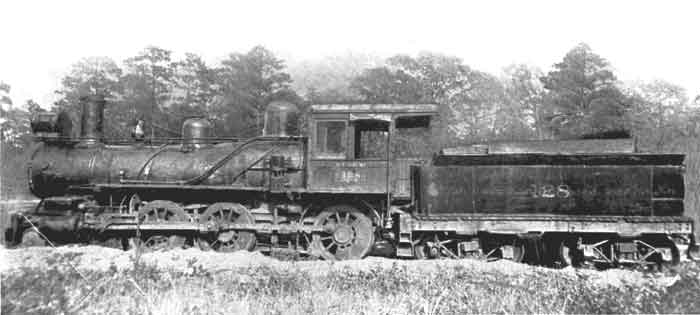
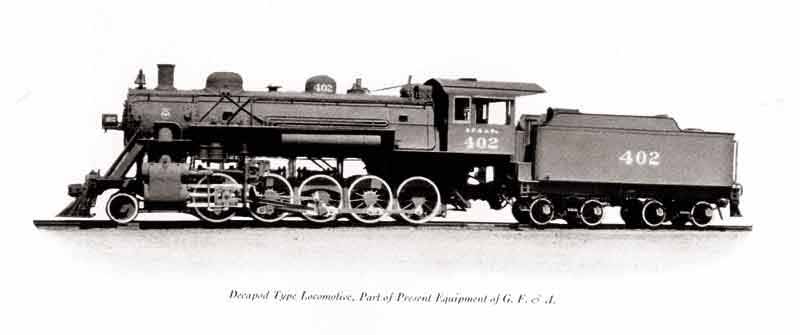

One of the more worn out 4-6-0s that
the GF&A needed to replaced in
the 1920's. (Hensley Collection)

One of the newly acquired Decapods. (Hensley Collection)
By 1927 the railroad was up for
sale, due to the death of Mrs. Williams, who had inherited the railroad
from her husband a few years before. A charity
trust fund was set up for a hospital and the railroad had to be sold to
fulfill the will. Seaboard stepped in and received approval from the
ICC
to refinance and reorganize the GF&A and to lease it to the
Seaboard
for 99 years. The bonds and a special non-voting stock issue as well as
the lease payments were promised to the Hospital Charity Trust Fund,
which also received the semi-annual interest payments and stock
dividends. The Seaboard received the actual voting stock and gained
control of the railroad, merging it into the Seaboard in 1928. The
Carrabelle to Tallahassee line was abandoned in 1948, after serving a
prominent role during World War Two as an important military line,
serving an amphibious base near Carrabelle. The Havana to Quincy branch
was abandoned soon after the merger because Quincy was already served
by the
Seaboard. The railroad north of Bainbridge is now operated by the
Georgia Southwestern RR, while the Bainbridge to Tallahassee line is
still operated by CSX with an important connection with the old ACL
line to Dothan and Montgomery.

GF&A # 403 with a typical long train of the late 20's. (Hensley Collection)
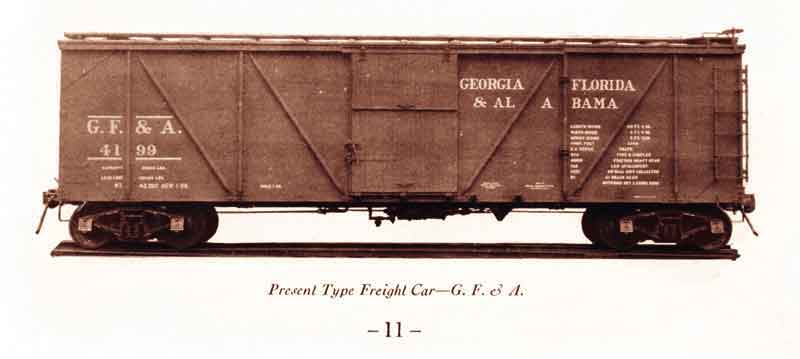
GF&A outside brace box car. (Hensley Collection)

GF&A hopper that was used for company coal use. (Hensley Collection)

A modern coaling station used by the GF&A. (Hensley Collection)
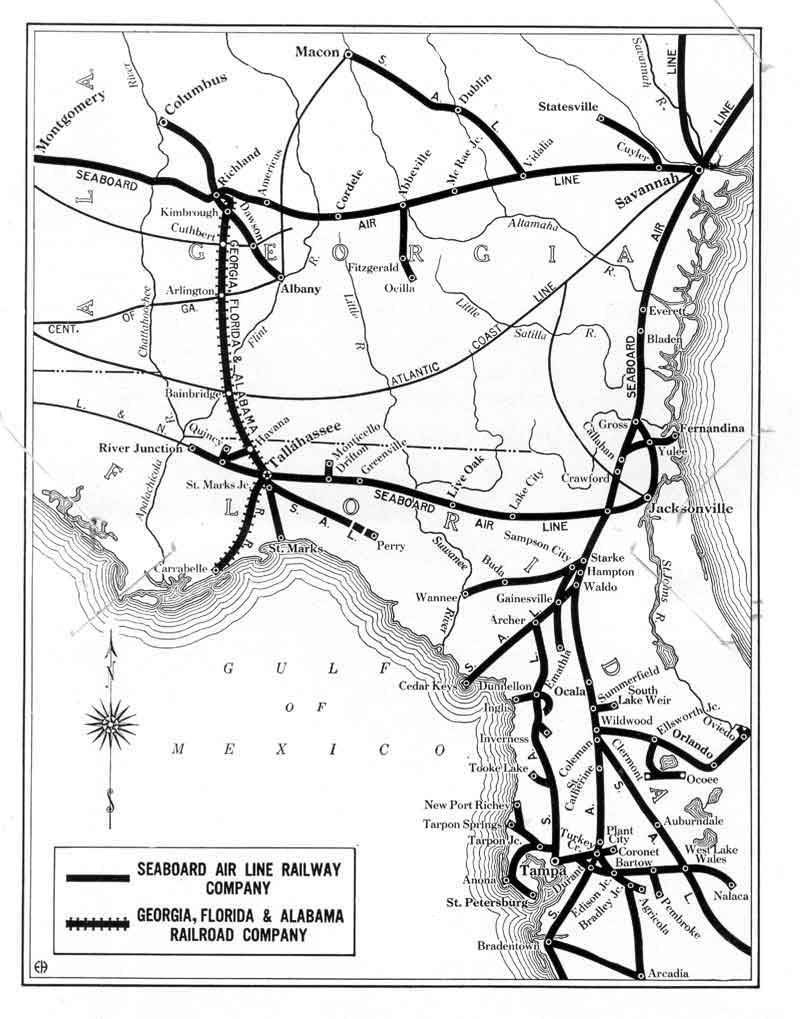
A map showing the GF&A and SAL systems just before the merger. (Hensley Collection)
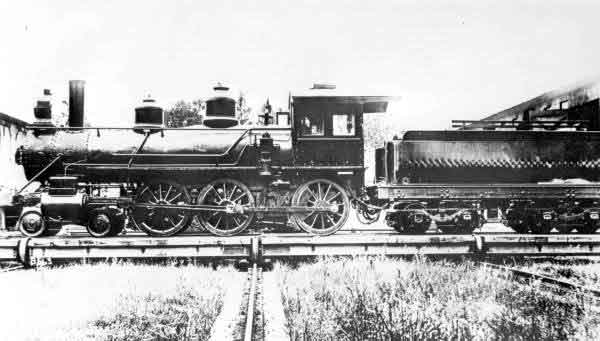
The original Georgia Pine Ry. # 1 (later
GF&A 1 and GF&A 121) is shown at the BR&L shops in
Birmingham in 1919 before its sale to the Bienville Lbr. Co. of Forest,
Miss. After the GF&A the ten-wheeler was sold to the GC&L
# 158 and then resold to Upchurch Lbr. Co. # 10 in 1919 and was
used for a short time in the Ocala National Forest area until Upchurch
Lbr Co. became insolvent and the engine was sold to BR&L.
